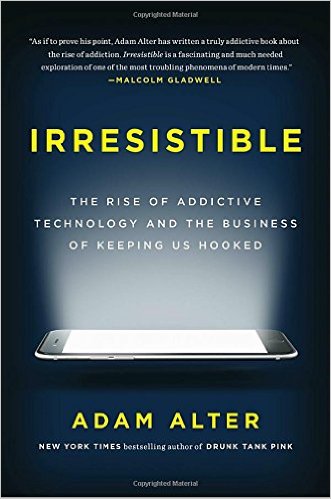I can describe this book with these two words: fascinating and disturbing. Why do people spend hours and hours gaming? On Facebook? Obsessed with Fitbits, unread emails, or people on Instagram? In Irresistible, author Adam Alter answers these questions and more.
Professor of psychology and marketing at NYU, Alter dives into what he calls the age of behavioral addiction. Behaviorally addicted to what? Technology. It comes with lots of positives, but it also has an underbelly – a dark side – that lives, and lives large. From social media worlds to gaming, that dark side involves how we humans find so many facets of it hard to resist. Alter lays out a clear and strong case why our technology is deliberately designed to get and keep us hooked.
The rise of addiction
Why have we seen a rise in people not only finding it challenging to use technology in moderation, but becoming behaviorally addicted to it? Alter gives us the answers. One theme comes from Tristan Harris, a design ethicist, who says it’s not so much that we lack the will power. It’s that thousands of people out there have jobs with the goal of breaking down our self-regulation.
How well are they doing? Take the Internet Addiction Test that appears early in the book and find out for yourself. My results – “mildly addicted.” That sure kept me reading.
Expanding understanding of addiction
Alter succinctly discusses how our historical understanding of addiction has been too narrow. Although we commonly think “addiction” strongly implies substance abuse, you’ll see how it encompasses much wider territory to include our behaviors. Whether it be online gambling, shopping, social media, gaming or email, the psychologists he talked with told him that every one of their clients has at least one behavioral addiction.
Irresistible also goes into an interesting discussion of addiction as a matter of perspective. For example, only a century ago, experts once considered cocaine a glorious panacea. We now know its dangers. But just as cocaine “charmed” experts at the time, today we, as Alter writes, are “enamored of technology.”
Alter examines the work of researchers like James Olds and Peter Milner who turned what we commonly think of as addiction on its head. Beyond the common assumption that drug addicts have some kind of predisposition, or they have an “addictive personality,” they purport that under the right circumstances “we could all become addicts.” That’s right. All of us.
What fuels behavioral addiction
You’ll learn a lot about – and hopefully also be disturbed by – what product designers do to so easily push our buttons to buy and use their products, not just once but over and over again. With the help of psychology experts, Alter examines the deeper psychological roots behavioral addiction. Much like drug abuse, biology is involved (behavioral cues trigger dopamine surge), but the rabbit hole goes deeper than that, to escapes from things like loneliness and distress.
Irresistible also unpacks how businesses know our motivational structures and engineer addictive experiences. The “Social Interaction” chapter particularly interested and troubled the psychologist and sociologist in me. For example, products designed as “engines for social feedback” have profound impacts on how people see themselves. When users don’t get “social confirmation” it can feel like a “social death penalty.” You’ll learn in spades how this is true for gaming as well.
Nipping addictions
Alter gives a decent discussion on how to nip behavioral addictions at birth, and a bit on habits we adults can employ, but I wanted more here. As assessed as ‘mildly’ behaviorally addicted, I finished the book not knowing what else to do than what I already do to keep my relationship with technology in check. As long as technology remains critical to the success of my professional endeavors, it will remain a challenge, especially as the age of technology continues to evolve.
However, when it comes to my technology use, I did leave the book even clearer about the power of self-observation, and that like understanding any relationship, with technology, it too, starts from within.


